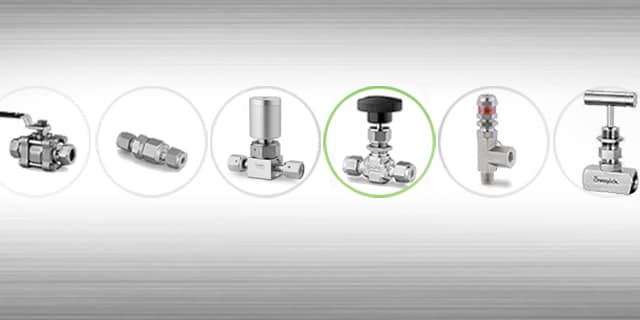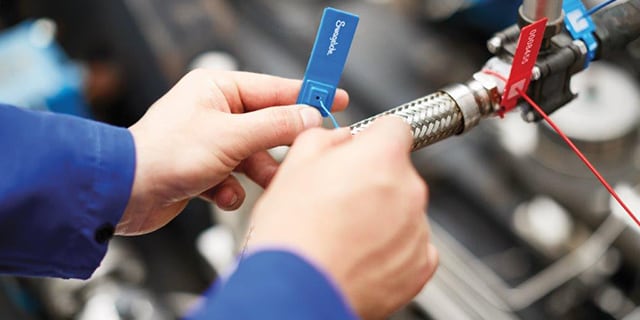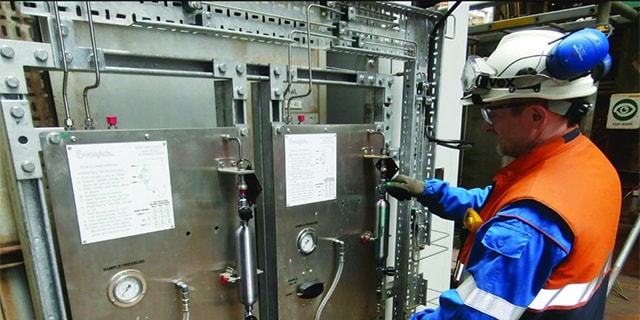How to Select Valves for Industrial Fluid Systems

How to Select the Right Valves for Your Industrial Fluid System
Valve selection is an important part of proper design and maintenance practices for industrial, piping, and instrumentation systems. Without the right valve for a specific application, operators could face improper or poor fluid system performance, increased downtime, and avoidable safety risks.

How do you make the right choice?
For proper valve selection, designers and technicians can follow the STAMPED method, which accounts for Size, Temperature, Application, Media, Pressure, Ends or fittings, and Delivery. Thorough consideration of each of these operational conditions can guide industrial fluid and analytical sampling system professionals to the right valve choice.
Here is how to apply STAMPED to your fluid system design:
 S: Size
S: Size
The size of your valve dictates its flow capacity and will need to correspond to the desired (or required) flow rate of your system. Manufacturers will provide a flow coefficient (Cv), which indicates the relationship between the pressure drop across a valve and the corresponding flow rate.
Flow coefficient, or Cv, is the amount of water in U.S. gallons per minute that will flow through a valve with a 1 psi pressure drop across the valve and at a temperature of 60°F. With compressible fluids, like gases, calculating and using the Cv parameter to predict flow is more complex, but still provides an effective means to size valves for a given application.
Valve design factors influencing Cv include the size and geometry of the flow path; the orifice size of a valve affects the flow of fluid through it. The larger the orifice, the greater the potential flow capacity. Orifices in different types of valves can vary considerably; for example, a ball valve will offer minimal flow resistance, but a needle valve can restrict or slow down flow. These should be considerations in your selection process.
When in doubt, consult your manufacturer—a good one will help in sizing the valve you need. For this purpose, Swagelok offers a handy Cv calculator that can be used as a starting point in selecting the right valve for your application.
 T: Temperature
T: Temperature
Keep in mind temperatures where your valve will be in operation. This includes both the temperature of the system media your valve will help control the ambient operating temperature of the surrounding environment. Ask yourself: “Will these temperatures be constant, or will they change frequently?” These conditions may influence your valve selection or how frequently you will need to perform preventive maintenance.
Consider temperature fluctuations that may cause sealing materials to expand and contract. Also, metallic components can lose strength at higher temperature, reducing pressure ratings. It is important to check with your manufacturer to confirm a valve has been fully tested at the extremes.
 A: Application
A: Application
Consider what your valve needs to do in your system. Do you need to start or stop flow? Regulate flow level? Control the direction of flow? Protect the system from overpressure?

 M: Media
M: Media
The process fluid inside your system should also be carefully considered as you seek to select the correct valve with the correct material composition. Make sure that your system media is compatible with the materials that make up your valve bodies, seats, stem tips, and other softer materials. Incompatibility can lead to corrosion issues, embrittlement, or stress corrosion cracking—all of which can pose safety risks, as well as costly production issues.
As with temperature, you should also consider where the valve will be placed into service. Will it operate in a climate-controlled environment, such as the inside of a plant or heated instrument enclosure? Will it be outdoors, exposed to elements such as direct sunlight, rain, snow, frost, ice, and temperature fluctuation? A marine environment with significant exposure to chlorides? Valves and their components come in a variety of materials. Choose those that are best suited to these factors to maximize the longevity and functionality of the valves.
 P: Pressure
P: Pressure
Pressure is another important consideration in your valve selection. Note the two different contexts in which the term is used:
- Working pressure: The normal operating pressure in your system.
- Design pressure: The valve’s manufacturer-provided maximum pressure limit; never exceed the design pressure of any fluid system component, unless doing so under controlled testing conditions.
A fluid system’s pressure limitation is based on its lowest-rated component—remember this when selecting your valve. Pressure and temperature of the process fluid have considerable impacts on component performance. The valve you select needs to hold pressure and operate when needed and under a wide range of temperatures and pressures. The design, material selection, and validation are all critical aspects of valve performance. Also remember that pressure and temperature impact one another considerably. Generally, as the temperature of the process fluid increases, the working pressure rating will decrease.
 E: End Connections
E: End Connections

 D: Delivery
D: Delivery
Once you have considered each of these factors and have selected the valve most appropriate for your application, ask yourself: “When do I need my valves? How many do I need?”
On-time delivery and reliable supply are just as important to keeping your fluid system operational and efficient as any other factor. As the final step of the STAMPED method, vet your suppliers. Are they able to get you the parts you need when you need them? Are they accessible? Will they work with you to understand your system needs?

Joe Bush is Senior Product Manager for Swagelok, and is responsible for setting the long-term vision and strategy for the general industrial valve product line. In his 26 years at Swagelok, he has a wide range of experience including technical service leadership for the high purity service group, Senior Pricing Analyst, and Market Manager for the Oil and Gas market.
Related Articles

Valves 101: What Fluid System Pros Should Know
Industrial valves play an important role in controlling the flow of media in critical fluid systems. Learn more about valve types, their functions, and how to make the right selection.

How to Improve Your Maintenance Program with Valve and Hose Tags
Hear from two Swagelok specialists how a robust tagging system for hoses and valves throughout your industrial fluid systems can help you simplify maintenance and minimize system downtime.

Thermal Relief Valves Systems from Swagelok Speed Production for Charbonneau Industries
Learn how Swagelok Custom Solutions helped Charbonneau Industries focus on their core capabilities by speeding production, reducing labor costs and securing system quality with prefabricated thermal relief valves systems.


